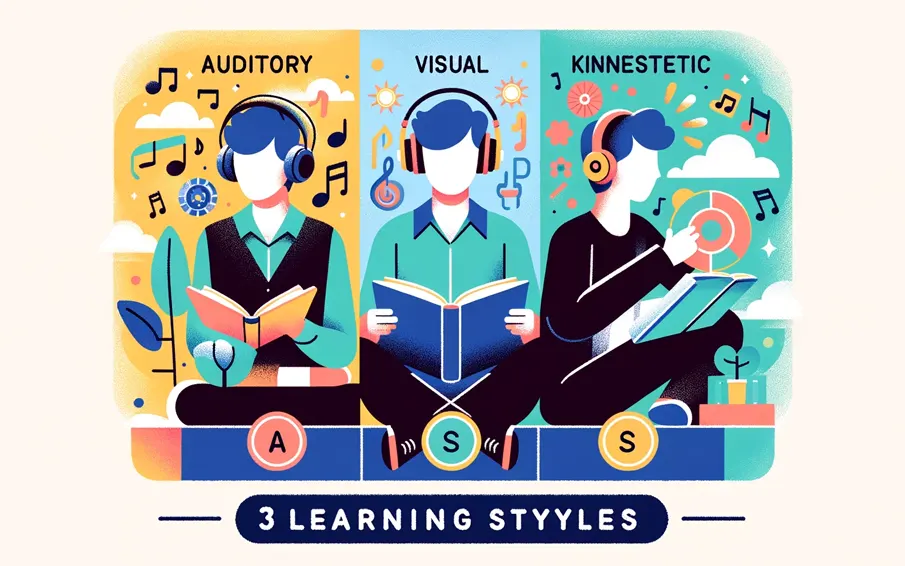This article presents a systematic exploration of the concept of learning styles, specifically focusing on the three primary types. Our objective is to provide a clear, evidence-based understanding of how different individuals approach learning. This exploration is grounded in educational psychology and pedagogical research, aiming to offer valuable insights for educators, students, and professionals. By examining the characteristics and implications of each learning style, we seek to enhance the efficiency of teaching methodologies and learning strategies, ultimately contributing to more effective educational outcomes. This introduction sets the stage for a detailed analysis of the 3 main types of learning styles, their identification, application, and impact on personal and professional development.

Understanding the 3 Types of Learning Styles
In this insightful exploration, we delve into the world of educational psychology to uncover the 3 different types of learning styles. Recognizing and understanding these styles is crucial in shaping our approach to teaching, learning, and personal development. Whether you’re an educator, student, or lifelong learner, this guide will help you identify and harness these styles to enhance your learning experience and educational outcomes.
Discovering the 3 Types of Learning Styles in Psychology
The field of psychology has long emphasized the importance of understanding how individuals learn differently. In this section, we explore the 3 types of learning styles from a psychological perspective, revealing how these styles impact both teaching and learning processes. This exploration is not just about identifying each style, but also understanding their psychological underpinnings. By comprehending these styles, educators and learners can develop more effective and personalized educational strategies.
- Visual Learning Style: Often recognized for its reliance on visual elements like images, diagrams, and colors, this style is about learning by seeing.
- Auditory Learning Style: This style is characterized by a preference for listening to information, be it through lectures, discussions, or audio recordings.
- Kinesthetic Learning Style: Kinesthetic learners prefer a hands-on approach, learning best through doing and experiencing.
The 3 Main Types of Learning Styles
This section focuses on providing an analytical overview of the 3 main types of learning styles. It aims to objectively examine each style, discussing their defining characteristics and their roles in the learning process. The intent is to offer a clear, concise understanding of how these styles contribute to different learning experiences and outcomes. By analyzing these styles, we can gain insights into more effective educational strategies and better align teaching methods with individual learning preferences.
Identifying Your Learning Style
Understanding your own learning style is crucial for effective learning and information retention. This section outlines methods to identify which of the 3 types of learning styles best suits you, and why it’s important to recognize this aspect of your learning process.
- Self-Assessment: Techniques and tools for self-evaluation to determine your preferred learning style.
- Feedback Analysis: Understanding feedback from educators and peers to identify your learning tendencies.
- Learning Style Quizzes and Tests: Utilizing structured quizzes and tests designed to pinpoint your unique learning style.
Recognizing your learning style not only enhances academic performance but also aids in personal and professional development, leading to a more tailored and effective learning experience.
Applying the 3 Types of Learning Styles in Educational Settings
This section provides a detailed examination of how the three types of learning styles can be effectively applied in various educational contexts. It aims to offer practical guidance for educators and learners on incorporating these styles into teaching methods and learning strategies. The focus is on understanding the unique aspects of each style and how they can be leveraged to improve educational outcomes. By adapting teaching techniques and learning approaches to align with these styles, the educational experience can become more engaging, efficient, and tailored to individual needs.
Exploring the 3 Types of Learning Styles through Interactive Quizzes
Interactive quizzes and assessments play a pivotal role in helping individuals identify their preferred learning styles among the three primary types. This section delves into the significance and utility of such quizzes in determining one’s learning style. These tools are designed to offer a deeper, more nuanced understanding of personal learning preferences, which can be invaluable in tailoring educational and training programs to one’s individual needs. By engaging with these quizzes, learners can gain insights into their learning habits and preferences, thus empowering them to make more informed decisions about their educational and professional development paths.
The Impact of Learning Styles on Personal and Professional Growth
Recognizing and utilizing your learning style has far-reaching implications beyond academic success. This section discusses the impact of understanding and applying the 3 types of learning styles on personal and professional development.
- Enhanced Learning Efficiency: Tailoring study methods to fit your learning style can lead to more efficient and effective learning.
- Improved Communication Skills: Understanding different learning styles improves your ability to communicate and collaborate with others who may have different preferences.
- Career Advancement: Awareness of your learning style can guide your approach to professional development, making training and skill acquisition more impactful.
Understanding your learning style is not just about academic achievement; it’s a tool for lifelong learning and professional growth, enabling you to adapt and thrive in various environments.
Conclusion
In conclusion, the exploration of the 3 types of learning styles reveals a diverse landscape of how individuals absorb and process information. This understanding is not merely academic; it’s a vital component of personal and professional growth. Recognizing and embracing these differences enables a more inclusive and effective approach to education and training. It allows for the development of more personalized strategies that cater to individual strengths and preferences, fostering an environment where every learner has the opportunity to thrive. As we continue to delve deeper into the complexities of human learning, the appreciation and application of these varied styles remain crucial for holistic development.


